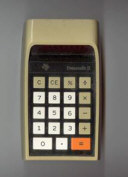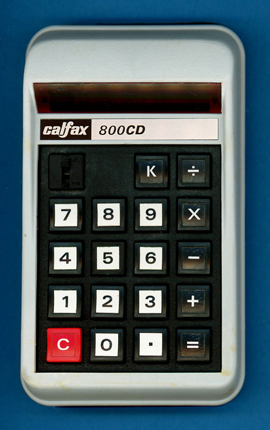
DATAMATH CALCULATOR MUSEUM
 |
DATAMATH CALCULATOR MUSEUM |
calfax 800CD
| Date of introduction: | March 1973 | Display technology: | LED modules |
| New price: | Display size: | 8 | |
| Size: | 5.1" x 3.2" x 1.5" 130 x 81 x 37 mm3 |
||
| Weight: | 4.9 ounces, 138 grams | Serial No: 046684 | 243663 |
| Batteries: | 9V Alkaline | Date of manufacture: | mth 10 year 1973 |
| AC-Adapter: | Origin of manufacture: | Hong Kong | |
| Precision: | 8 | Integrated circuits: | General Instrument CZ-550 |
| Logic: | Chain Logic | Displays: | |
| Memories: | |||
| Program steps: | Courtesy of: | Joerg Woerner |

![]() American Import Merchants Corporation of New York filed in January 1973 for the
calfax Trademark, importing electronic calculators from Asia and distributing them in America. As of today we identified about 15 different calculators manufactured between 1973 and 1975 in Hong Kong.
American Import Merchants Corporation of New York filed in January 1973 for the
calfax Trademark, importing electronic calculators from Asia and distributing them in America. As of today we identified about 15 different calculators manufactured between 1973 and 1975 in Hong Kong.
We acquired this calfax 800CD calculator in 2025 on our quest to complete the Characterization of Single-Chip Calculator Circuits of General Instrument's C-500 Product Family of Single-chip Calculator Circuits.



 Dismantling
the featured calfax 800CD calculator manufactured in October 1973 in Hong Kong
reveals a highly cost-optimized design based on a single-sided printed circuit board
(PCB) for the main electronics and powered by a 9-Volt battery or an external power adapter.
Dismantling
the featured calfax 800CD calculator manufactured in October 1973 in Hong Kong
reveals a highly cost-optimized design based on a single-sided printed circuit board
(PCB) for the main electronics and powered by a 9-Volt battery or an external power adapter.
 The
Main-PCB is centered around a General Instrument CZ-550 single-chip calculator circuit and the other remaining components on
the PCB are mainly used to interface the display and keyboard. The Main-PCB also
includes a small transformer to generates the
different supply voltages for the CZ-550.
The
Main-PCB is centered around a General Instrument CZ-550 single-chip calculator circuit and the other remaining components on
the PCB are mainly used to interface the display and keyboard. The Main-PCB also
includes a small transformer to generates the
different supply voltages for the CZ-550.
![]()

 To
gain some knowledge about the differences between the
CZ-550 located in this calfax 800CD, the
C-550 used with the Interton PC 2008 and the
CZL-550 used with
the Radofin Model 2200, we
decided here at the Datamath Calculator Museum to give it a "Teardown
Treatment" and sharing our findings accordingly.
To
gain some knowledge about the differences between the
CZ-550 located in this calfax 800CD, the
C-550 used with the Interton PC 2008 and the
CZL-550 used with
the Radofin Model 2200, we
decided here at the Datamath Calculator Museum to give it a "Teardown
Treatment" and sharing our findings accordingly.
 Calculating Unit:
The CZ-550 used with the calfax 800CD is a member of the third generation of
General Instrument single-chip calculator circuits and traces back to the famous
PICO1 introduced already in 1971:
Calculating Unit:
The CZ-550 used with the calfax 800CD is a member of the third generation of
General Instrument single-chip calculator circuits and traces back to the famous
PICO1 introduced already in 1971:
|
1971: GEN1 GI 250 (76250) and GI 251/251F (76251) 4-digit display or 4-digit multiplexed 8-digit display, 25 Volt 1972: GEN1 C-500 (76251) 4-digit multiplexed 8-digit display, 25 Volt 1973: GEN2 C-550/CZ-550 - 4-digit multiplexed 8-digit display, 15 Volt 1973: GEN3 C-560/C-570 - 8-digit display, 15 Volt 1974: GEN4 CZL-550 8-digit display, trailing zero suppression, integrated segment drivers, 15 Volt |
 Display:
The featured calfax 800CD calculator manufactured
in October 1973 makes use of an 9-Digit LED Display assembly consisting of three
unknown 3-digit LED modules, soldered with its 17 pins directly to the
Main-PCB. The rightmost digit of the LED Display assembly is not used with the
CZ-550 chip.
Display:
The featured calfax 800CD calculator manufactured
in October 1973 makes use of an 9-Digit LED Display assembly consisting of three
unknown 3-digit LED modules, soldered with its 17 pins directly to the
Main-PCB. The rightmost digit of the LED Display assembly is not used with the
CZ-550 chip.
Display Driver: Early single-chip calculator circuits like the PICO1,
Mostek's MK6010 or Texas Instruments'
TMS0100 didn't include any display drivers
and left the choice of display technology and necessary interface circuitry to
the designers of the electronic calculators. The PMOS (p-channel Metaloxide
Semiconductor) technology used with these chips was neither compatible with
Vacuum Fluorescent Displays (VFDs) nor with Led Emitting Diode (LED) Displays:
| VF Display - Operating voltage (30 to 45 V) higher than chip voltage (15 to 25 V) LED Displays - Operating current (10 to 50 mA per digit) higher than chip output current (1 to 5 mA) |
Progress with both display technology and chip technology allowed around 1972/1973 the direct connection of low-voltage (< 35 Volts) VF Displays to single-chip calculator circuits with modified "high-side" segment and digit output drivers to withstand up to -35 Volts. In a next step, around 1973, the used PMOS chip technology allowed beefier "high-side" segment drivers while the LED displays exhibited increased efficiency, meaning they could be operated with lower currents. The digit drivers still used external "low-side" drivers. Rockwell introduced in June 1974 with the A5300 Product Family the first single-chip calculator circuits with LED (Light-Emitting-Diode) Direct-Drive capability, integrating not only the segment drivers but the digit drivers, too.
The General Instrument CZ-550 chip uses only 4 digit outputs, labeled D15, D26, D37, and D48, requiring an external "demultiplexer" to operate an 8-digit display. The dismantled calfax 800CD calculator uses a very simple and straightforward approach to interface with the LED display:
| Eight discrete, inverting transistors are connected in two groups of four to the D15, D26, D37, and D48 digit outputs of the CZ-550 chip Two additional transistors are connected to the UD_EN and LD_EN outputs of the CZ-550, selecting the upper or lower digit groups The outputs of the eight transistors are connected to the Common Cathodes D2 to D9 of the LED display (D1 is not used) The A to G and DP segments (Anodes) of the LED display are driven directly from the CZ-550 chip |
We did not expect to find a CZ-550 driving the segments of an LED display directly and we decided to measure the Segment Driver Output Characteristics of the salvaged chip. A closer look at the PCB of the calfax 800CD calculator reveals that the design uses carefully selected transistors with small variation in their gain to limit the digit currents of the display while operating the LED segments without current limiting resistors. We estimate the pulsed segment currents in the range of around 6 to 8 mA, explaining the rather dim display of the featured calculator.
Clock: The CZ-550 single-chip calculator circuit of the calfax 800CD is
operated with a frequency of about 70 kHz.
Power Supply: The calfax 800CD calculator is powered with a disposable
9-Volt alkaline battery or an external 9 Volt power adapter
and uses a simple DC/DC converter to generate an additional negative voltage for
the CZ-550:
|
VSS - Positive supply for CZ-550 (+9.0 V) from battery GND - Negative supply for LED Display (0 V) from battery VDD - Negative supply for CZ-550 (-6.6 V) from DC/DC converter |
We measured the operating current of the featured calfax 800CD calculator for two different cases:
| Mode | Display | Current VBAT = 9.0 V |
Clock Frequency |
| Calculating | 0 | 48 mA | 70 kHz |
| Calculating | 88888888. | 56 mA | 70 kHz |
Calculating the power consumption at 9 Volts for the calfax 800CD results in about 430 mW displaying a '0' and about 500 mW with all segments illuminated. An unusual high idle value, a similar designed MBO Expert, centered around a TMS0833 single-chip calculator circuit, clocked in at 120 mW displaying a '0' but consumed about 500 mW with all segments illuminated, too.
 Keyboard:
The keyboard assembly of the calfax 800CD uses 18
plastic keys pushing individual metal fingers soldered on a single-sided PCB against
large, gold-plated contacts mounted on the PCB.
Keyboard:
The keyboard assembly of the calfax 800CD uses 18
plastic keys pushing individual metal fingers soldered on a single-sided PCB against
large, gold-plated contacts mounted on the PCB.
 Here
at the Datamath Calculator Museum we use
the DCM-50A Platform to
Characterize and
Reverse-engineer
Single-chip Calculator Circuits. Many designs of electronic calculators do not
use all features of their calculator brains and it would be difficult to unleash
the full potential of the calculator chips in these cases. Additionally are
electronic calculators "closed systems" with limited flexibility to measure
signals, change voltages or clock frequencies, provide additional input keys or
even change the display technology or specifications additional digits. Core
idea of the DCM-50A is providing a generic platform to access all features of a
single-chip calculator circuit and with the
DCM-50A (PLAYGROUND) we
increased the scope from Texas Instruments products to offerings from their
competitors in the 1970s, namely AMI, Cal-Tex, Commodore/MOS Technology,
Electronic Arrays, General Instrument, Hitachi, Litronix, Matsushita,
Mitsubishi, Mostek, National Semiconductor, NEC, Omron, RFT, Rockwell, Sharp,
Toshiba, and Western Digital.
Here
at the Datamath Calculator Museum we use
the DCM-50A Platform to
Characterize and
Reverse-engineer
Single-chip Calculator Circuits. Many designs of electronic calculators do not
use all features of their calculator brains and it would be difficult to unleash
the full potential of the calculator chips in these cases. Additionally are
electronic calculators "closed systems" with limited flexibility to measure
signals, change voltages or clock frequencies, provide additional input keys or
even change the display technology or specifications additional digits. Core
idea of the DCM-50A is providing a generic platform to access all features of a
single-chip calculator circuit and with the
DCM-50A (PLAYGROUND) we
increased the scope from Texas Instruments products to offerings from their
competitors in the 1970s, namely AMI, Cal-Tex, Commodore/MOS Technology,
Electronic Arrays, General Instrument, Hitachi, Litronix, Matsushita,
Mitsubishi, Mostek, National Semiconductor, NEC, Omron, RFT, Rockwell, Sharp,
Toshiba, and Western Digital.
On our quest to document Pico Electronics' PICO1 Chip and its
many descendants like the General Instrument C-500, C-550, CZ-550, C-560, C-570 and
CZL-550, we developed here at the Datamath Calculator Museum three additional
tools for our DCM-50A (PLAYGROUND):
| DCM-50A
(PLAYGROUND) C-500
Family Adapter: Daughter Board for the
DCM-50A (PLAYGROUND)
Frame Carrier for
General Instrument's C-500 Portfolio DCM-50A (PLAYGROUND) KBD102 Keyboard: Keyboard with 20 individual keys to support the PICO1-style keyboard reading DCM-50A (PLAYGROUND) Digilent I/O Extender: Plug-In Board to add six additional Input Signals for the Digilent Discovery |
Comparing the Calculator Logic Implementation of the CZ-550 retrieved from the featured calfax 800CD calculator with the Calculator Logic Implementation of the C-550 chip reveals no differences other than the "trailing zero suppression".
Comparing the Segment Driver Output Characteristics of the CZ-550 with the Segment Driver Output Characteristics of the CZL-550 reveals a substantial difference and makes us wonder why the calfax 800CD omits external segment drivers.
Don't miss the "Picolator" on the German Richi's Lab site, an Emulator for General Instrument's C-550 single-chip calculator circuit - still using the PICO1 program code from the original GI 250 chip.
If you have additions to the above article please email: joerg@datamath.org.
© Joerg Woerner, August 3, 2025. No reprints without written permission.